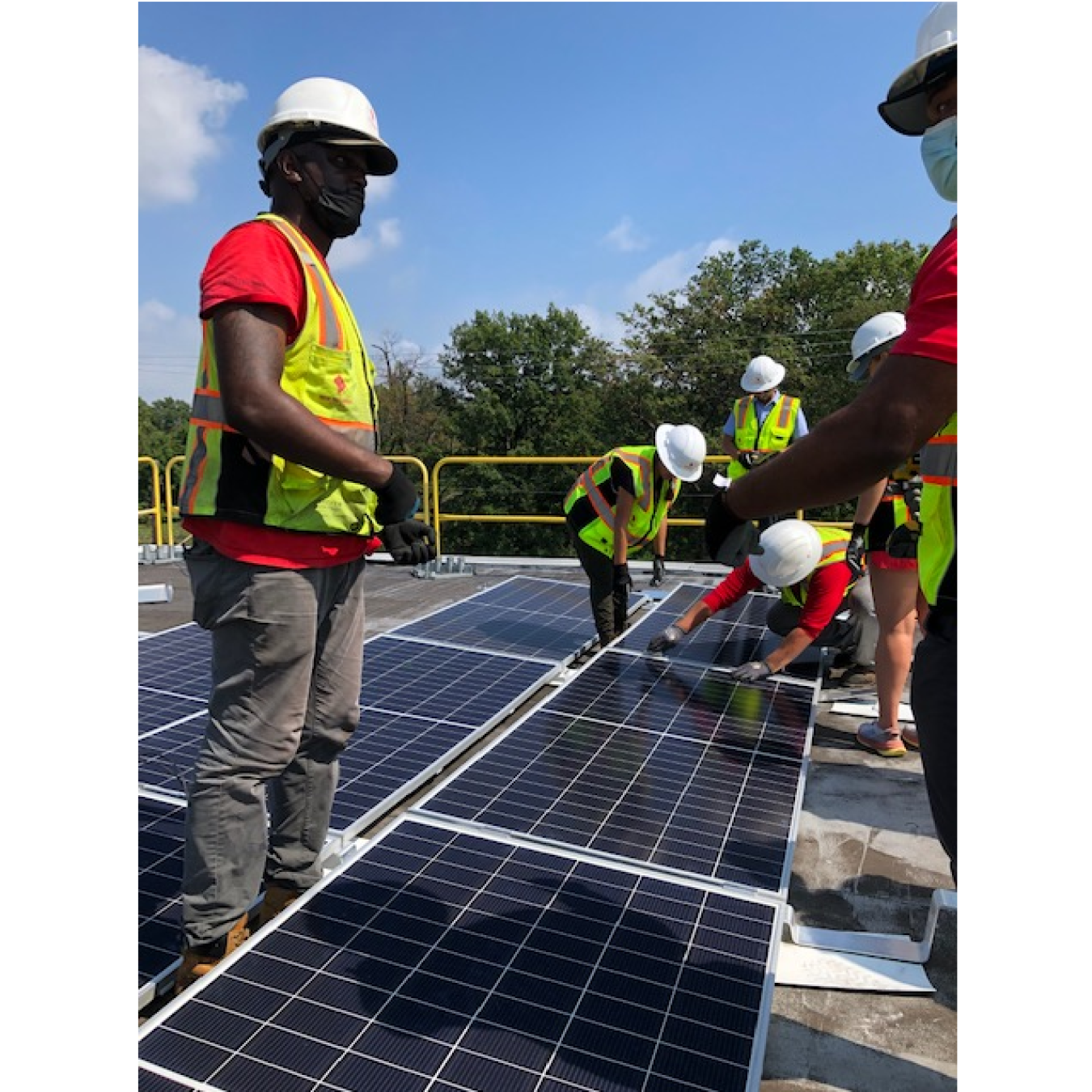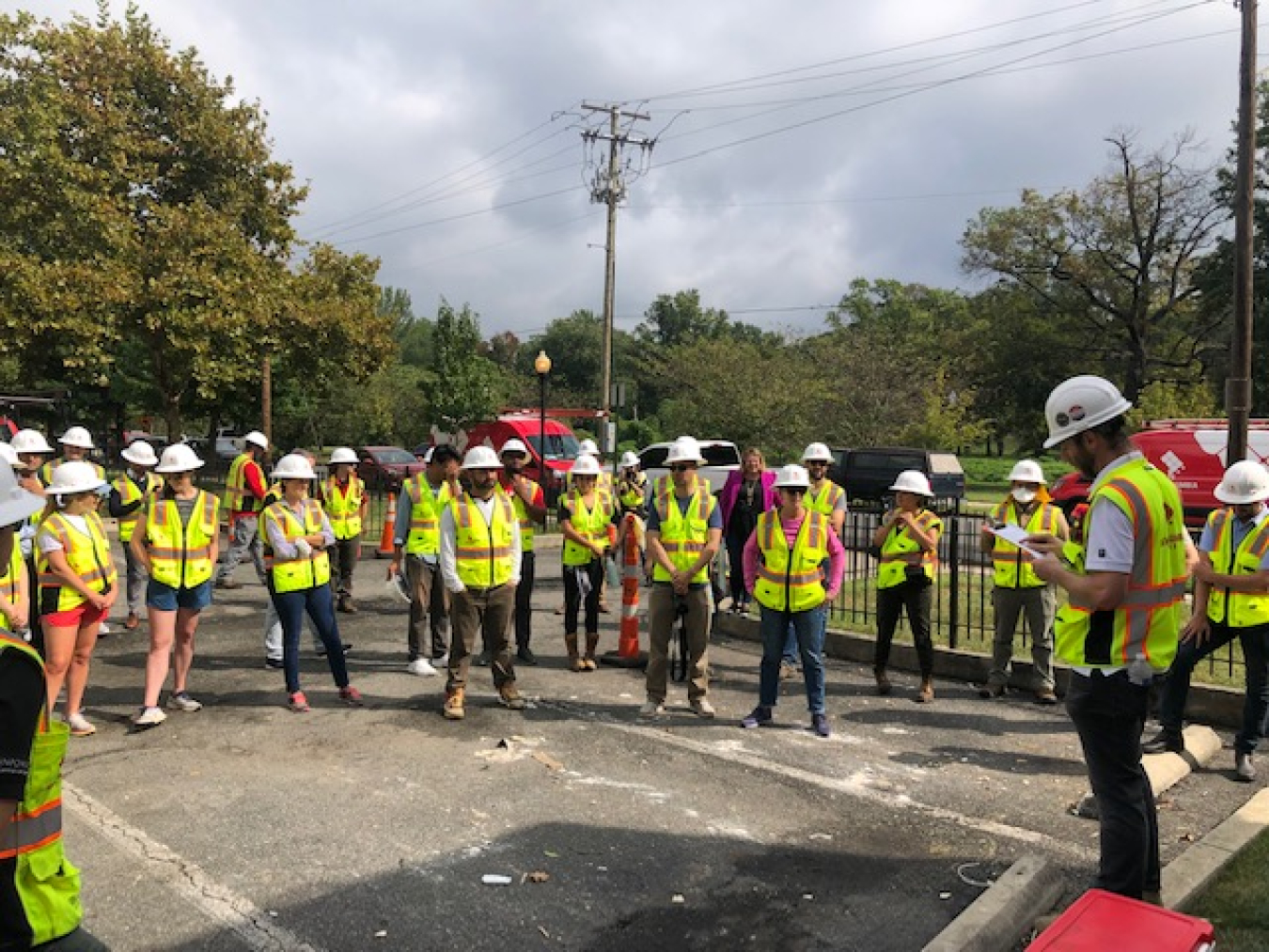Team members celebrate the completion of a community solar installation outside Crescent Park Village in Washington, DC.
On a beautiful fall day this year in Washington D.C., members of the White House Climate Team put on their hardhats and safety vests and came together to transform Crescent Park Village rooftop into a community generator—not just of power, but local economic opportunities, which deliver meaningful benefits to the community. These 829 panels will generate nearly 400 kW of electricity and will help more than 100 D.C. households cut their electricity bills in half over the next 15 years as part of DC’s Solar For All program.
D.C.’s program is an example of a model for solar adoption that’s growing across the country—community solar. Community solar is a form of energy generation where community members subscribe to a portion of a solar array, usually located near their community. As the solar array produces energy, subscribers receive a portion of the revenue from the energy produced, typically as a credit on their monthly electric bill.
Community solar installations expand access to solar to anyone who cannot--or does not--want to put solar on their roof. This can include those who may not own their homes, including apartment dwellers or residents of homeowners associations with restrictive covenants, or aren’t ready to make the financial investment in a solar energy system, and they can provide other benefits for neighborhoods, such as better resilience of their electricity grid during storms and opportunities to start a career in solar energy. But it’s not always easy to develop a community solar project. State and local policy, access to finance, and technical challenges can all be barriers to community solar—especially for small developers and community-based organizations.

Team members work together to install solar panels in the community solar array on the rooftop of Crescent Park Village in Washington, DC.
The U.S. Department of Energy’s National Community Solar Partnership (NCSP) aims to change that. With its new rolling technical assistance program, community-based organizations, small developers, and other partners will be able to request free technical expertise at any time to transform the market for community solar and increase access to the meaningful benefits of renewable energy for all Americans. The program has already distributed $1 million in technical assistance and hopes to provide $2 million in the next year.
This technical assistance could be used to replicate Washington D.C.’s Solar for All program, for example, which provides grants to organizations that wish to install a community solar system. By the end of 2021, the D.C. Solar for All program will have helped cut electricity bills in half for nearly 6,000 income-qualified D.C. households.
In Texas, DOE technical assistance helped the Texas Energy Poverty Research Institute (TEPRI), a collaborative of stakeholders that address energy and poverty, to develop a community solar model that would provide financial and environmental benefits for underserved communities. TEPRI will install a solar system on a commercial host site that will distribute a portion of the revenue to local community-focused organizations. They also wanted to make sure this model could scale, maximize the economic impact for all stakeholders in the project, and, importantly, that it would not require any policy change. DOE helped TEPRI validate their model and is now helping them vet potential sites to implement it.

Team members, wearing hard hats and safety vests, receive a briefing from their crew leader before beginning a community solar installation in Washington, DC.
Several thousand miles away, the Hawaii Public Utilities Commission was looking for methods of verifying eligibility of low-income applicants to their Community-Based Renewable Energy program that would be easy and economical for the subscriber organization and the applicant. Through DOE’s technical assistance, the Commission developed a series of recommendations on methods to verify LMI customers without creating additional burden on the applicants or the subscriber organizations. The Commission adopted these recommendations to ensure that more residents can access community solar.
In Massachusetts, DOE provided technical assistance to develop an interactive tool that enables residents to search for open community solar projects in the state. The tool will be available on Massachusetts Clean Energy Center’s ‘Clean Energy Lives Here’ website. A data visualization specialist from the National Renewable Energy Laboratory collected and analyzed publicly available data to create a map that is straightforward and engaging. Empowered with this information, more Massachusetts residents will be able to make informed decisions about renewable energy for their households.
If your community is looking to replicate programs like these, join the National Community Solar Partnership. All NCSP partners are eligible to apply for technical assistance. As part of the application process, partners can request support for a variety of community solar needs, like research on regulatory or policy issues, preparation materials for project financing, strategies for engaging with and acquiring subscribers, and more. After submitting a technical assistance application, the level and type of assistance will be determined on a rolling basis. The type of technical assistance they receive can take a variety of forms, too, from consultations to technical review of plans to general information and education to technical analysis.
By providing these services to small developers, community-based organizations, and other partners that may not have this expertise in house, technical assistance makes the community solar market accessible to all.
Learn more about DOE’s National Community Solar Partnership and its technical assistance.